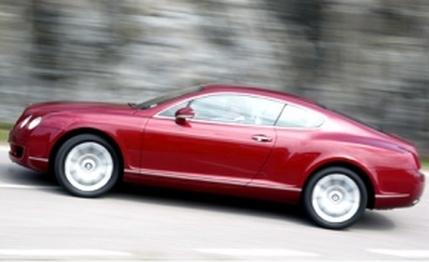
 First Drive Review
First Drive Review
Walter Owen Bentley has had plenty of reasons to spin in his grave during the past 32 years as the storied brand he founded withered and the cars bearing his name declined into souped-up, badge-engineered shadows of their snootier Rolls-Royce Shadow, Spur, and Seraph siblings. His spinning surely must have redlined in 1998 when what was left of the Rolls/Bentley empire was auctioned off to the Germans-the same crowd he'd helped to defeat in World War I by designing radial aircraft engines for British warplanes.
Bentley's dramatic win at Le Mans this year after a 73-year absence must have assuaged Walter Owen's soul somewhat, and the first road car produced by Volkswagen-fostered Bentley Motors seems certain to return him to peaceful rest. In fact, we half wonder if the advanced product-planning research didn't include séance-facilitated communication with the founder himself, so faithfully does this new Bentley Continental GT adhere to his car-design tenets.
W.O.'s career began in the railway business, so perhaps it's not surprising that when he turned his attention to building automobiles, he built them large and sturdy, with huge, powerful engines. Their speed and reliability helped them win Le Mans five times from 1924 through 1930, and their imposing size led another automaker, Ettore Bugatti, to refer to the 1930 4 1/2-liter supercharged Le Mans winner as "the fastest lorry in the world." The Continental GT is infused with the attributes of those champions.
Large and sturdy? The Bentley's platform is shared with the all-steel VW Phaeton sedan. The GT's bodywork is shortened 9.9 inches, lowered 2.4 inches, widened 0.6 inch, and perched on a 5.3-inch-shorter wheelbase. The body shell is so rigid that if you clamped the rear of the GT in a giant vise and hung a second GT (weighing 5250 pounds) from one of the front wheels, the structure would twist only one degree. The cowl is sedan high, and the seats are well off the floor-for easy entry, exceptional visibility, and ample space for four adults and their luggage.
And the engine? Would six liters divvied up among 12 cylinders force-fed by two turbos and two intercoolers good for 552 horsepower and 479 pound-feet of torque qualify as "huge and powerful" in your book? We can't comment on reliability except to say that in pursuit of same, a Continental GT was run for 18,500 miles at 175 mph at the Nardo test track in Italy.
The W-12 engine (picture two VR6s on a common crank) is based on the powerplant used in the Audi A8, but it gets unique low-compression pistons to handle boost levels of between 4.4 and 10.2 psi huffed up by twin 3K Warner turbochargers. That pressure arrives instantly and imperceptibly, providing peak torque at just 1600 rpm. The engine is hand-assembled at the Bentley factory in Crewe.
A ZF six-speed automatic digests that immense torque and apportions it evenly between the front and rear axles via a torque-sensing center differential (see Technical Highlight: Bentley, page 80). Ordinary drive, sport, and Tiptronic shift modes are offered, with manual shifting via paddles behind the wheel or the usual lever.
Style and elegance matter as much as size, space, and power to today's Bentley buyer, and in these, too, the car excels. This coupe has an undeniable sense of gravitas; it is at once imposing, graceful, feline, and muscular.
There's no mistaking this Bentley for anything with just five digits behind the dollar sign. Climb in, and the nose is treated to the scent of fine leather while the eyes and fingers encounter nothing but double-stitched leather, aluminum, and book-matched burled-wood trim on practically every surface. Even the rear seat is first-class, with no surface impinging on this 5-foot-11 scribe sitting behind a front seat adjusted to his driving position.